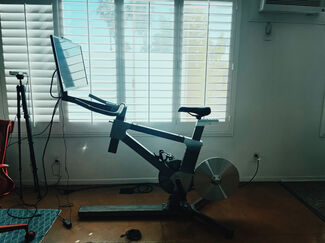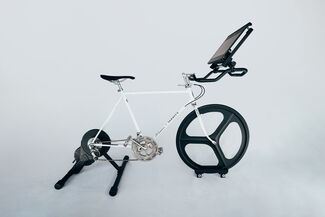
SAGA HoloBike
Alum Samuel Matson’s HoloBike is Transforming the Fitness Industry
Can’t find the time to get out of your house for a bike ride? No problem. When you ride a HoloBike, you feel like you’re riding on an actual trail. Developed by School of the Art Institute of Chicago (SAIC) alum Samuel Matson (BFA 2013), the exercise bike is an enticing view into the possibilities of how holographic technology can intermix with fitness. Matson’s approach to the creation and design of the HoloBike involved the sort of interdisciplinary thinking he learned at SAIC, combining sculpture, industrial design, 3D mapping, and more.
“The HoloBike is about bringing it back to the experience and joy of, call it exercise, sure, but just movement,” said Matson. “I think what we discovered and what we could tap into was this sense of moving through space and how important that is for humans as we move our bodies. We’re programmed to get a dopamine response out of the sense of moving through space.”
Matson came to the idea in Colombia after leaving his job at Google. That initial three months turned into 12 months due to the pandemic, which prompted him to cycle every day with friends throughout the Andes Mountains. On his bike, three hours would go by and only felt like 30 minutes.
This feeling, which Matson pinpoints as “time dilation,” became the center point of the HoloBike’s creation. With his experience in virtual reality (VR) development in Silicon Valley, he knew of VR headsets’ limitations, and came to holograms as the pionering solution. Holographic technology creates all of the immersion the HoloBike needed without the clunky headset and limited mobility.
An important aspect of tapping into that sensation of movement is the mapping of real-life trails into digital models for the HoloBike. The process begins with photos and scans, which combine with the map and topographical data, and are then all combined into a digital model to recreate the trails.
After toying with the idea for a couple of weeks in Colombia, he booked a flight back to Los Angeles and began the process of prototyping there. “I got an old 1987 Schwinn bike, threw it on these trainer wheels, just off the shelves. Found a used audio stereoscopic display, paired it with an eye tracking camera, slapped that on the bike. Wrote some software to make it all work together. And was surprised that it actually worked,” said Matson.
With its mapping of trails, design, functionality, and visual identity the HoloBike combines so many areas of study that Matson explored through SAIC’s Sculpture, Designed Objects, and Art and Technology departments. “I never stopped to question whether I should traverse all these domains, whether I should stick to software or hardware,” he said. “It just happened very naturally.”
When he began showing the prototype to people, Matson recalls how an athletic friend immediately clicked with the HoloBike. While training for an Ironman triathlon, his friend was forced to begin training indoors and immediately lost motivation. He then went on to tell Matson how the HoloBike’s holographic trails would break the monotony of staring at a wall. At that point, Matson knew the HoloBike found its niche within the fitness market.
So what’s the future of HoloBike? When asked about what’s next, Matson is ambitious: “Ideally, we’re going to map the world.”



